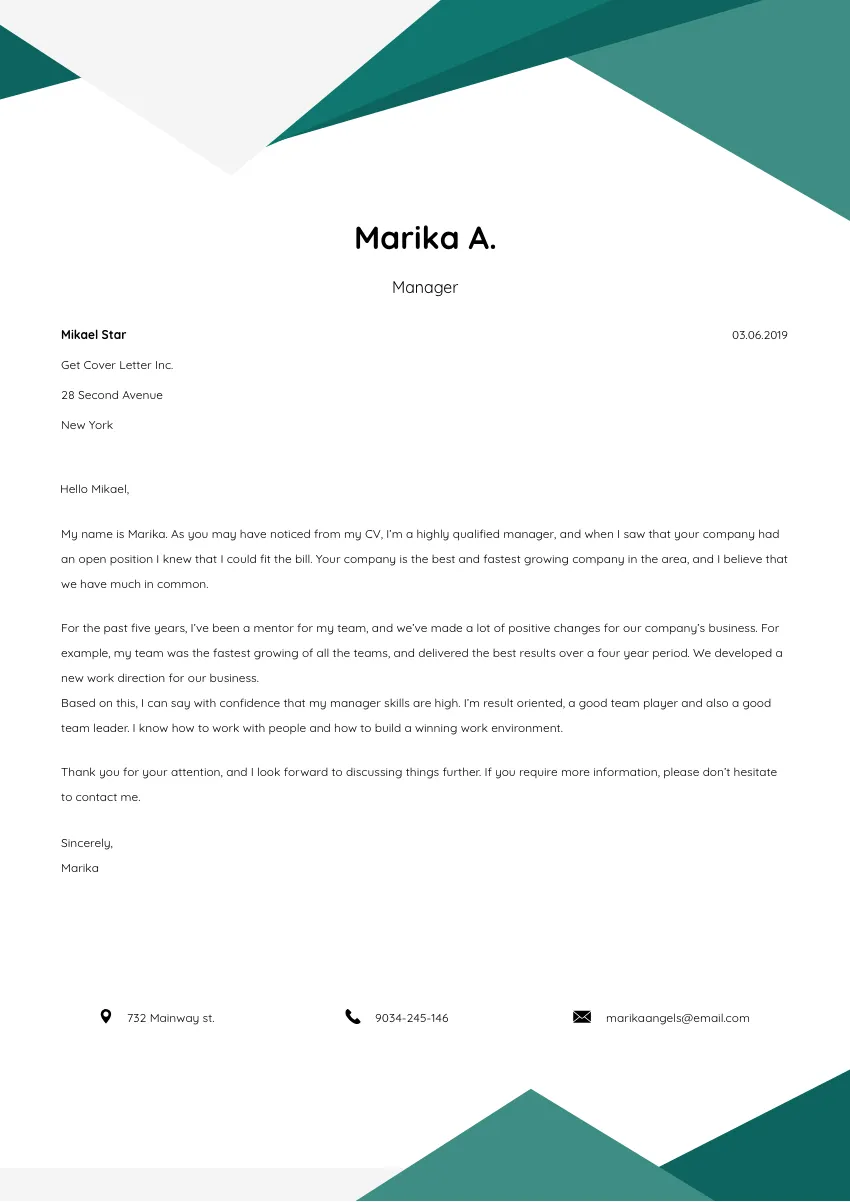Crafting a Powerful School Nurse Cover Letter
A well-crafted cover letter is your first chance to make a strong impression and secure an interview for a school nurse position. It’s more than just a formality; it’s a crucial marketing tool that showcases your skills, experience, and passion for student health. This guide will walk you through the essential steps to create a cover letter that stands out from the competition and highlights why you are the ideal candidate. The goal is to present yourself in the best possible light, demonstrating your understanding of the role and your commitment to the well-being of students. A compelling cover letter can significantly increase your chances of landing your dream job as a school nurse, ultimately contributing to the health and safety of the school community. Follow these steps, and watch your application rise to the top.
Understanding the Purpose of a Cover Letter
The primary purpose of a cover letter is to introduce yourself to the hiring manager and provide context for your resume. It’s your opportunity to tell your story, explaining why you’re interested in the specific school nurse position and how your qualifications align with their needs. Unlike a resume, which is a factual summary of your experience, a cover letter allows you to express your personality, enthusiasm, and unique value proposition. Think of it as a conversation starter that encourages the reader to delve deeper into your qualifications. By clearly articulating your career goals and demonstrating your understanding of the school’s mission, you create a compelling narrative that sets you apart from other applicants.
Highlighting Your Key Skills and Experience
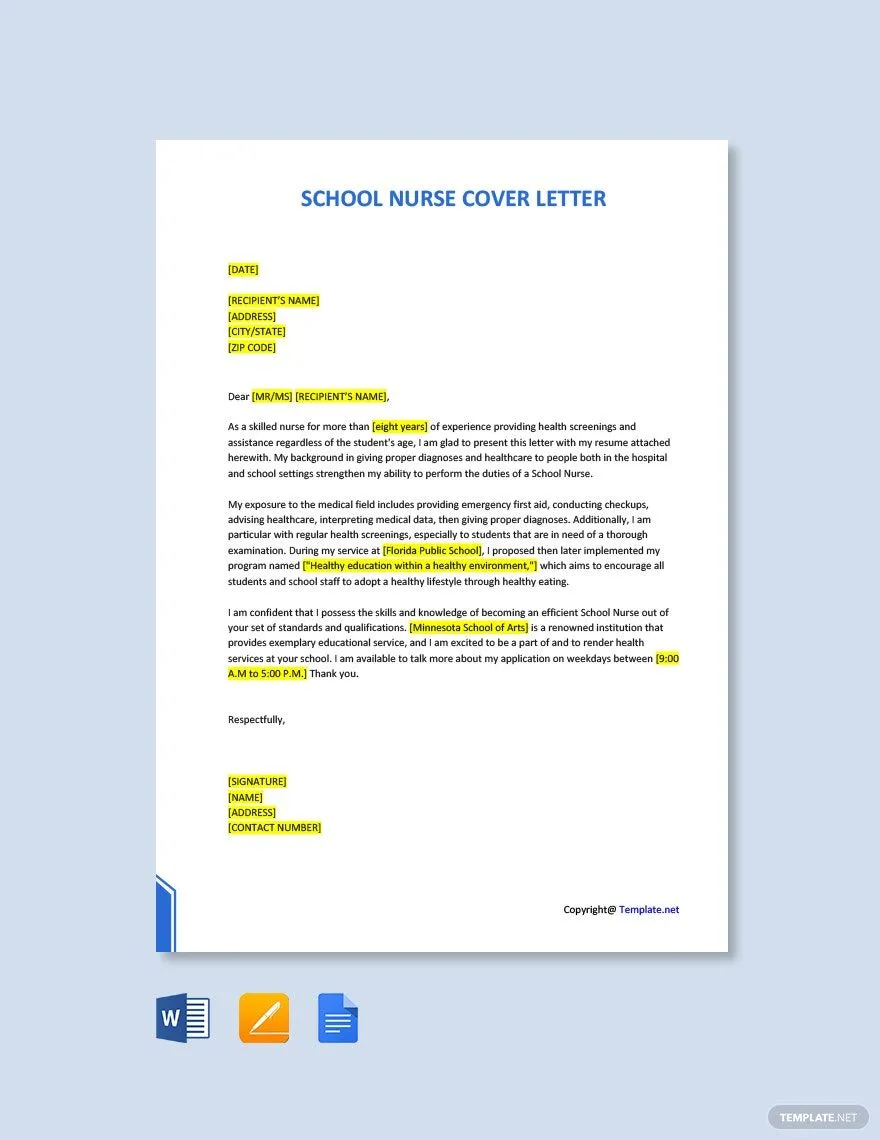
Your cover letter should immediately showcase your most relevant skills and experience. This is where you connect the dots for the hiring manager, demonstrating how your background makes you a perfect fit for the role. Instead of simply listing your qualifications, provide specific examples of how you’ve applied these skills in previous roles. Quantify your achievements whenever possible using numbers and data to illustrate your impact. This section is your chance to show, not just tell, the hiring manager why you’re the best candidate.
Essential Skills for a School Nurse
School nurses require a unique blend of clinical expertise, communication skills, and compassion. In your cover letter, emphasize skills such as assessment, first aid, medication administration, and health education. Highlight your experience in managing chronic conditions like asthma and diabetes, as well as your ability to handle emergency situations. Also, remember to mention soft skills like empathy, patience, and the ability to build relationships with students, parents, and staff. Demonstrate your ability to work both independently and collaboratively as part of a team, and showcase your skills in health promotion and disease prevention, which are vital in a school setting. Make sure to mirror the job description requirements.
Showcasing Relevant Experience
Provide specific examples of your experience that directly relate to the school nurse position. This might include previous roles in pediatric care, community health, or school nursing. If you’ve managed student health records, implemented health programs, or provided health education to students and staff, be sure to mention these experiences. Quantify your achievements whenever possible. For example, you could state how you reduced student absenteeism by implementing a specific health program or how you successfully managed a crisis situation. Use action verbs to describe your accomplishments and highlight your ability to make a positive impact on student health.
Tailoring Your Cover Letter to the Job
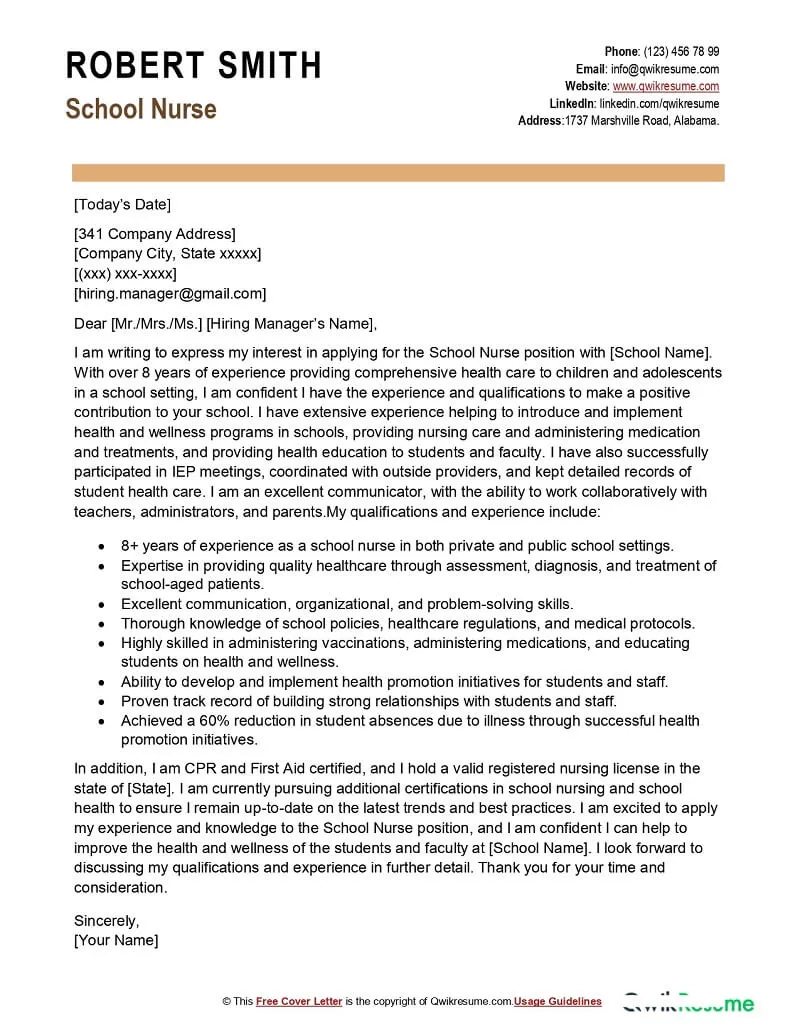
Generic cover letters rarely make a strong impression. Customizing your letter for each specific job application is crucial. This shows the hiring manager that you’ve taken the time to understand their needs and that you’re genuinely interested in the position. Start by carefully reviewing the job description and identifying the key requirements and qualifications. Then, tailor your letter to address these specific points, highlighting how your skills and experience align with their needs. Mention the school name, and if possible, reference any programs or initiatives that resonate with you. This tailored approach will demonstrate your genuine interest and increase your chances of getting an interview.
Researching the School and Its Needs
Before you start writing, research the school and its needs. Visit the school’s website to learn about its mission, values, and any special programs or initiatives. If possible, review any recent news articles or publications related to the school. This research will give you valuable insights into the school’s culture and priorities, allowing you to tailor your cover letter accordingly. Pay attention to any specific challenges the school may be facing, such as a high rate of chronic illnesses among students or a need for increased mental health support. If the school emphasizes any specific health programs, mention those programs in your cover letter, showing your alignment with their objectives.
Matching Your Skills to the School’s Requirements
Carefully analyze the job description and identify the key requirements and qualifications. Use these requirements as a framework for your cover letter, demonstrating how your skills and experience match the school’s needs. Provide concrete examples of how you’ve successfully applied these skills in previous roles. For example, if the job description emphasizes experience with asthma management, describe your experience providing care for students with asthma. If the school prioritizes health education, highlight your experience developing and delivering health education programs. Tailor your letter to include keywords from the job description, this will help the hiring manager see your relevance to the position.
Formatting and Structure of Your Cover Letter
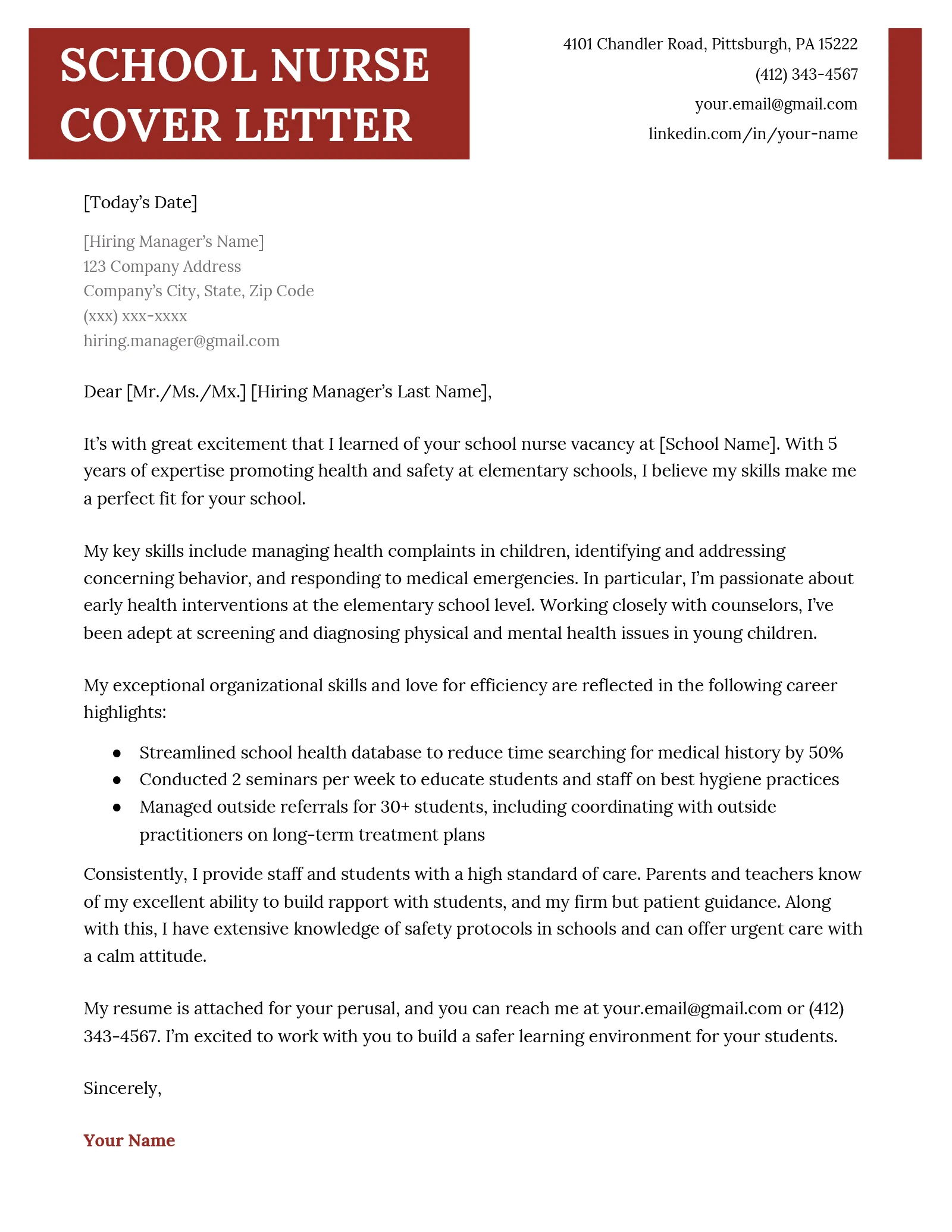
A well-formatted cover letter is easy to read and professional in appearance. Use a clean, professional font like Times New Roman or Arial, and maintain consistent formatting throughout. Keep the letter concise, ideally no longer than one page. The structure of your cover letter should follow a standard format that includes a header, salutation, body paragraphs, and a closing. Proofread carefully for any errors in grammar or spelling before sending your application. Proper formatting demonstrates your attention to detail, enhancing your professional image and making a positive first impression on the hiring manager.
Header and Contact Information
Your header should include your name, address, phone number, and email address. Also, include the date and the hiring manager’s name and title, if known, along with the school’s address. If you’re applying for an online position, provide the name of the person you’re addressing the letter to or the hiring team. Ensure your contact information is accurate and up-to-date. It’s essential to make it easy for the hiring manager to contact you. Use a professional email address. Double-check the spelling of all names and addresses to prevent any communication errors.
Professional Salutation and Tone
Start your cover letter with a professional salutation, such as “Dear Mr./Ms. [Last Name],” or “Dear Hiring Manager.” Avoid informal greetings like “To Whom It May Concern.” Maintain a professional and respectful tone throughout your cover letter. Use clear, concise language and avoid slang or jargon. Express your enthusiasm for the position and your genuine interest in the school. Demonstrate your passion for school nursing and your commitment to student health. Be positive and confident in your writing. Your language and tone will demonstrate your commitment to the position.
Body Paragraphs that Impress
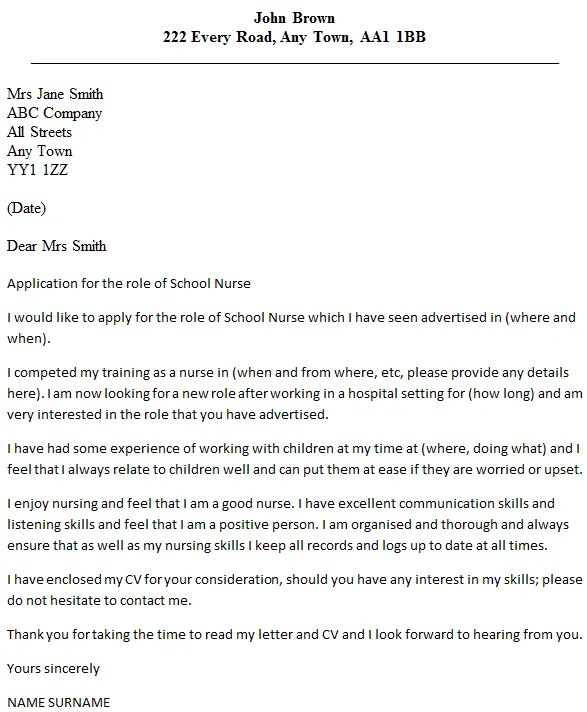
The body paragraphs are the core of your cover letter, where you showcase your qualifications and make your case for why you’re the ideal candidate. Focus on highlighting your key skills, relevant experience, and achievements. Provide specific examples to demonstrate your impact and quantify your accomplishments whenever possible. Use the STAR method (Situation, Task, Action, Result) to structure your responses, providing a clear and concise narrative of your experiences. Tailor these paragraphs to match the job description. By following these tips, your body paragraphs will set you apart from the competition.
Opening Paragraph: Grabbing Their Attention
Your opening paragraph is your chance to make a strong first impression. Start with a compelling statement that immediately grabs the hiring manager’s attention. State the position you’re applying for and express your enthusiasm for the opportunity. Briefly mention your key qualifications and why you’re interested in the school. Tailor your opening paragraph to reflect the school’s mission and values. The goal is to make the reader want to learn more. Consider starting with a brief anecdote that highlights your relevant skills and experience. Always convey your strong interest in the position and the school.
Middle Paragraphs: Demonstrating Value
In the middle paragraphs, provide specific examples of your skills and experience. Use action verbs to describe your accomplishments and quantify your achievements whenever possible. Highlight your relevant experiences, such as managing student health records, providing first aid, or implementing health education programs. Focus on experiences that align with the job description. Whenever possible, use the STAR method to structure your examples. For instance, you may describe a situation where you managed a student’s chronic illness. Detail the tasks involved, the actions you took, and the positive results you achieved. Demonstrating your value in each section is key.
Closing Paragraph: Call to Action
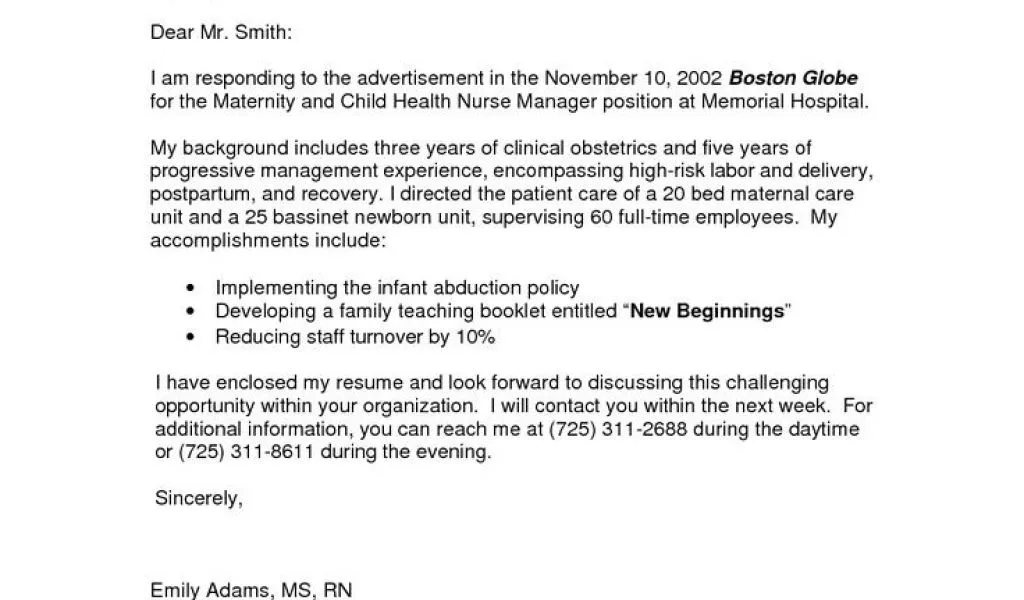
End your cover letter with a strong call to action. Reiterate your interest in the position and express your enthusiasm for the opportunity. Thank the hiring manager for their time and consideration. Include a statement indicating that you’re available for an interview and provide your contact information again. Make sure to sound confident and eager to discuss your qualifications further. This helps ensure that the hiring manager remembers you and makes them more likely to contact you for an interview.
Proofreading and Polishing Your Cover Letter
Proofreading and polishing your cover letter is essential to ensure it’s free of errors and presents you in the best possible light. Carefully review your letter for any grammatical errors, spelling mistakes, or typos. Read your letter aloud to catch any awkward phrasing or unclear sentences. Ask a friend, family member, or career advisor to proofread your letter as well. This will help you identify any mistakes you may have missed. Proofread your cover letter several times, and ensure that it aligns with your resume and the job description. A polished cover letter will showcase your attention to detail and professionalism.
Common Mistakes to Avoid
Avoid common mistakes that can undermine your cover letter. Do not use generic cover letters. Ensure your cover letter is tailored to each job. Avoid typos and grammatical errors, as these can create a negative impression. Don’t include irrelevant information or too much detail, as this may cause the reader to lose interest. Don’t focus on what you want, and instead, focus on the school’s needs. Do not use slang or informal language, and always maintain a professional tone. By avoiding these common mistakes, you can significantly improve your chances of landing an interview.
Seeking Feedback for Improvement
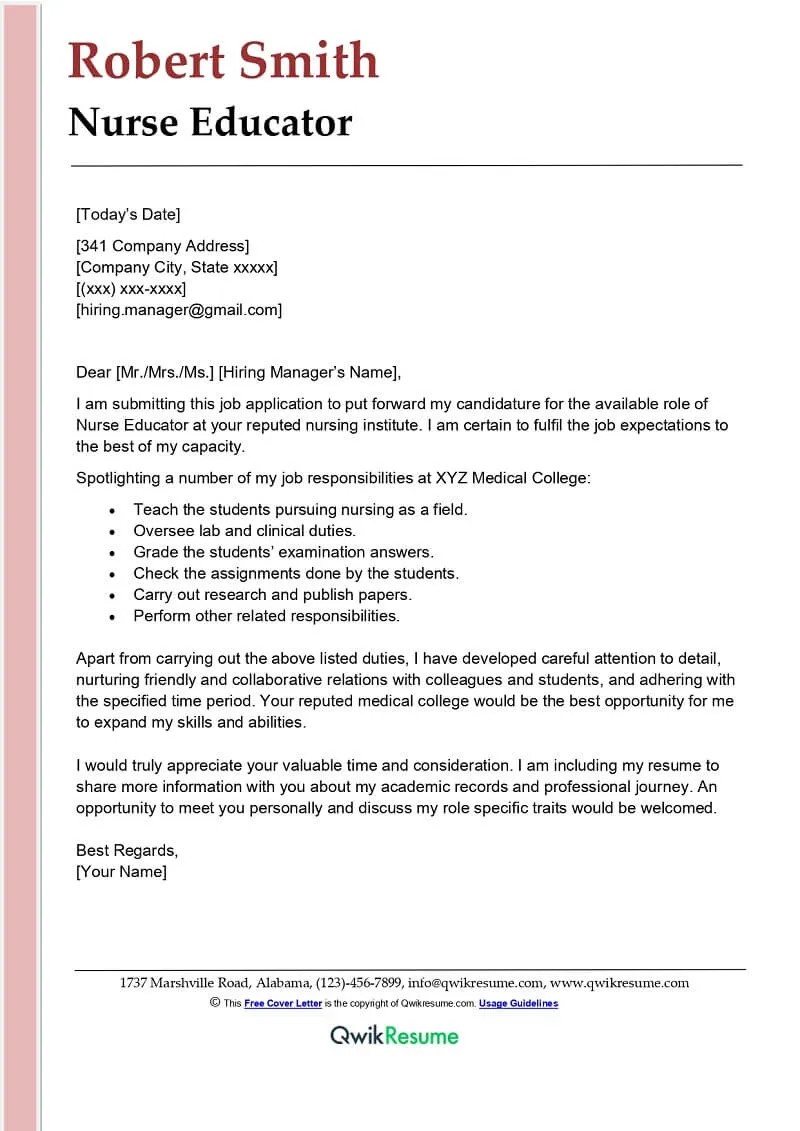
Before submitting your cover letter, seek feedback from trusted sources. Ask a career advisor, mentor, or friend to review your letter and provide constructive criticism. They can offer valuable insights into the clarity, organization, and overall effectiveness of your letter. Ask them to check for any errors in grammar, spelling, or formatting. Request feedback on the tone and content of your letter to ensure it aligns with the job requirements and your qualifications. Be open to receiving feedback, and use it to improve your cover letter. This will greatly help increase your chances of getting an interview.
